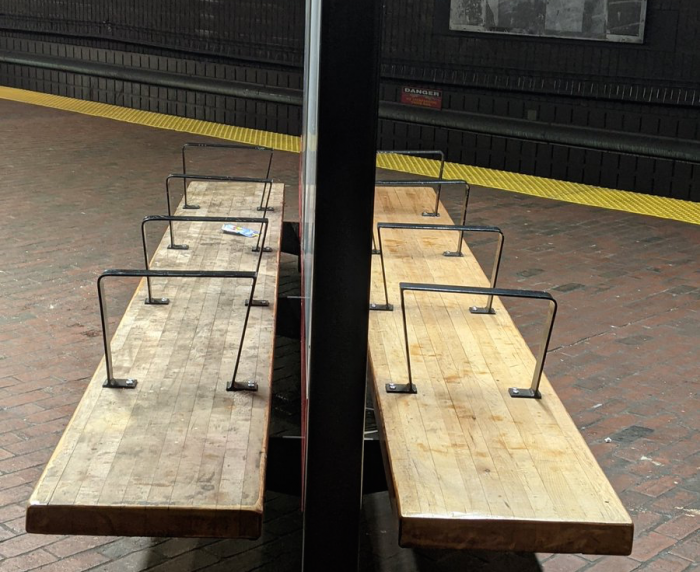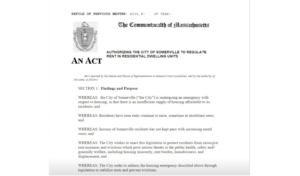Advocates say additions to benches in the Davis Square T stop send a striking message to the homeless
(Somerville Wire) – Designs described as “hostile architecture” appeared at the Davis Square T-Station over two months ago and have also been installed by the MBTA in stations in Cambridge and Boston. Black armrests made from steel are positioned on benches, partitioning the spaces into individual units. While the MBTA has said that the structures are meant to serve as supports for people with mobility challenges, residents and political figures have both criticized them for deterring unhoused people from using the benches as places to sleep.
Willie Burnley Jr., a candidate for City Council, has made banning hostile architecture a part of his campaign. According to Burnley, these elements create an intentional barrier and can be seen across the country in forms such as spikes on ledges, preventing a human being from resting, or studs “where they shouldn’t be there.” Burnley explained how what appears to be a design feature actually plays into a larger conversation about equity.
“Architecture isn’t just one thing or one mechanism. It is an entire strategy of design to impede people’s freedom of movement within a city and their ability to find rest in particular places,” said Burnley. “When we talk about what this is and how we combat it in our city, we have to realize that just like all systems of oppression, it is flexible, and it changes over time.” He added, “I don’t think it is a reflection of our city’s values to make it a hostile environment for people who are in the worst places in their life, who are hitting rock bottom. For me, this is about making sure we can be as kind to everyone in our community as possible. At the same time, I want to make sure the focus around this issue can be applied to the larger issue of chronic homelessness in our community.”
Councilor Katjana Ballantyne put forward two orders at an April 8 City Council meeting, which will be further discussed on May 3. The first order asked for the director of mobility and the commissioner of public works to work with the state delegation to remove the hostile architecture from public benches at Davis Square. The second order called for the commissioner of public works to ensure that no hostile architecture on public benches be installed in the city. Ballantyne said that she was motivated to take action when she saw the unwelcoming armrests at Davis Square.
“My thoughts were that the MBTA should have had a conversation with our community,” said Ballantyne. “They should have done some outreach, especially with organizations who work with the unsheltered population. The first thought is, let’s collaborate; let’s not just be reactive. Homelessness still continues, and this isn’t anything new—so why this hostile architecture? Why now and why in Davis Square? For me personally, I don’t support any kind of hostile design in Somerville’s urban environment. I don’t want to live in a city with bars and spikes on benches and not with any intentionally ugly and uncomfortable [features], other hostile furniture equipment.”
According to Lisa Battiston, deputy press secretary for the MBTA, the armrests were designed to help people with disabilities. In an email, Battiston wrote that the additions to the benches were not created to be restrictive.
“Designed by the MBTA’s system-wide accessibility department, the armrests offer structural support for customers with mobility challenges when they want to stand up or sit down,” wrote Battiston. “The T’s design standard for benches calls for armrests per ADA (Americans with Disabilities Act) guidelines. Benches are being modified as station improvement projects continue throughout the transit system. The objective is in a directive from the T’s chief engineer: Design for Benches for all new construction, repair or replacement projects shall follow standards that are consistent with MBTA’s priorities to the safety and accessibility of our passengers. As such, design shall prioritize safety, functionality, and ease of maintenance over time.” She added, “No one is prohibited from using the benches.”
However, Chair of the Commission for Persons with Disabilities Bonnie Denis said that the armrests are not really an advantage for people with disabilities but mainly serve as obstructions for people without homes. In an email correspondence with Ballantyne, Denis wrote that if the MBTA’s intention was to help disabled people, there are other ways they could have accomplished this goal.
“These are deterrents for unhoused people, many of whom have disabilities. I saw these images on Twitter this morning and to say I was disappointed with these being installed in Somerville would be an understatement,” wrote Denis. She added, “Further thoughts after seeing the MBTA’s responses to the tweeted pictures—there are ways to add armrests that would not clearly signal they do not want people sleeping on the benches. Benches with an arm on either end, or separate rails alongside the benches, for example. It is extremely unlikely that every person sitting on a bench would have mobility impairments that would necessitate the need for an arm rest.”
State Representative Mike Connolly is currently working on a bill that would ban hostile architecture that targets unhoused individuals. The legislation is still in draft form and Connolly said that he welcomes any feedback from concerned individuals or organizations. It establishes that anyone “who installs or constructs hostile architecture on any publicly accessible real property shall be punished by a fine of not more than $500 per day.” Connolly is still working on refining a definition.
“For purposes of this section, the term ‘Hostile architecture’ shall, unless the context clearly requires otherwise, mean any building or structure that is designed or intended to prevent unhoused individuals from sitting or lying on the building or structure at street level; provided, that hostile architecture shall not include design elements intended to prevent vehicles from entering certain areas,” reads the bill.
Burnley said that while he does not believe the MBTA had any malicious intent, the hostile architecture makes spaces inaccessible and does not send a message of inclusivity in the city.
“Easily for decades, you can go back and see little ways that cities have tried to make it so that people couldn’t be here,” said Burnley. “A lot of this is related to and stems from anti-loitering laws, which themselves have a pretty discriminatory history. But this is, in some ways, just the structural manifestation of a belief in a practice that says, ‘some people are undesirable, they shouldn’t be in our community, and we’re going to make it as hard as possible for them to be here, so that they go somewhere else.’”
All Somerville Wire articles may be republished by community news outlets free of charge with permission and by larger commercial news outlets for a fee. Republication requests and all other inquiries should be directed to somervillewire@binjonline.org.
Shira Laucharoen is assistant director of the Boston Institute for Nonprofit Journalism and assistant editor and staff reporter of the Somerville Wire.





